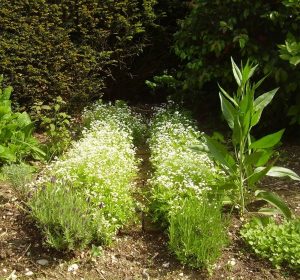Winter in Europe, apart from admiring flowers that defy the frost and pondering on structural strengths and weaknesses in a garden, is time for reflection and planning ahead. And to admit mistakes and think about ways of rectifying those.

Dittander, or peppercress, growing alongside woodruff
Whilst I was much in praise of woodruff recently or was dwelling on the collective strength of herbs, I have a word of warning to say about dittander, Lepidium latifolium, also known as pepper cress. Who would not fancy perennial cress ready to be picked all season and without the annual need to sow out repeatedly? It is a brilliant addition to fresh salad and has a distinct hot taste somewhat comparable to mustard, nasturtium and horse radish. So far so good.
Dittander is an imposing plant (by European herb garden standards) which comes back even stronger after being pruned harshly, to quickly produce small and even tastier fresh leaves in abundance. Like a Hydra? Yes! And, unfortunately, not only above but even more so below ground since it develops a wicked root system to shoot up everywhere. It compares well to ground elder or couch grass in that regard. Both have medicinal and nutritious qualities, too.
At first I was rather happy, since I tend to acquire a single plant first and then look how it propagates for me. This doesn’t contradict the useful practice to better plant in groups, it just means that the planting progress takes longer, which doesn’t matter if applied in one’s own garden or at an experimental stage. I proudly gave many offspring to friends praising the qualities of an easy care-free plant but should have been a little more cautious and added some qualification: The weedy habits of some herbs need to be taken into consideration.

Lepidium latifolium spreads by both seeds & runners
By all means, try this plant but in a well-defined restricted area and with measures to prevent the roots from rambling. It is really invasive. Large pots might be a solution, a cold frame of its own, a place in the kitchen garden where you dig and fork around all year, or a secluded if not neglected spot if you happen to garden in a large enough area with far away neighbours.
For herb nurseries, though, this plant seems to be a “no-brainer”, perhaps best to be advertised as a secret, low maintenance and forgotten species, never mind that in some areas of the world it has to be at least restricted since it can disturb or overwhelm ecosystems (as I know by now). Yet, one’s owl is another’s nightingale as the German proverb says, and after I discovered that the well known and loved North German herb nursery Rühlemanns even sells stinging nettle seeds I have become somewhat relaxed about having presented friends with a potential Pandora’s Box.
In any case, the fascination of collecting plants should ideally be accompanied by studying their natural habitat a little. Otherwise it could end up as described in many old fairy tales like the Sweet Pie, or in Goethe’s Sorcerer’s Apprentice. (and the English translation)
Which is, of course, an evergreen problem not only gardeners have to deal with.
[Note for Australian readers – Lepidium latifolium seeds are prohibited in Tasmania]
